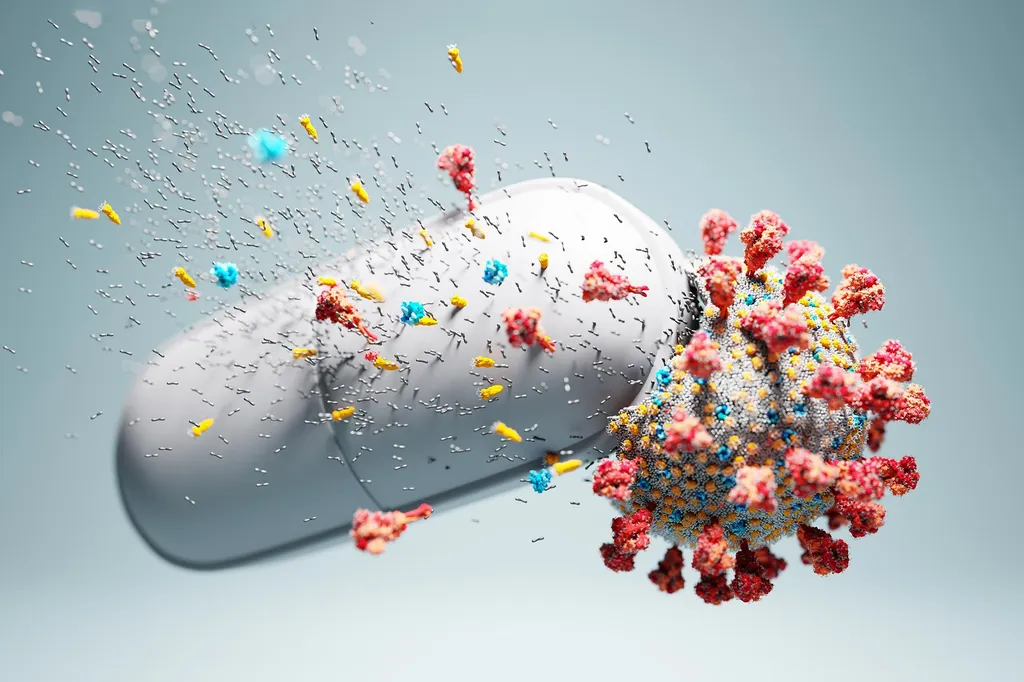

Researchers, looking to identify potential antiviral therapies that are effective against COVID-19, found that the antibiotic clofoctol may be an effective treatment for SARS-CoV-2 infections in mice.
Study in mice suggests Clofoctol inhibits SARS-CoV-2 replication and reduces lung pathology.
Repurposed drugs often have a speedier path to clinical use because they have already been shown to be safe in people. A research study that was published on May 19th in the open access journal PLOS Pathogens by Sandrine Belouzard and Jean Dubuisson at Pasteur Institute, Lille, France, and colleagues suggests clofoctol may be an effective treatment for SARS-CoV-2 infections in mice.
While COVID-19 vaccines reduce hospitalizations and death, they do not control virus transmission, and affordable, effective therapies are needed. Previous attempts to repurpose medicines to treat COVID-19 patients have been unsuccessful thus far. In order to identify potential antiviral therapies that are effective against COVID-19, the scientists accessed the Apteeus drug library, a collection of 1,942 approved drugs to identify molecules that exhibit antiviral activity against SARS-CoV-2. The authors selected clofoctol based on its antiviral potency. They tested their hypothesis by measuring clofoctol’s effects in SARS-CoV-2-infected mice.

Clofoctol was identified as a potential antiviral against SARS-CoV-2 following a cell-based phenotypic screening of approximately 2000 drug compounds that have been used or are still used in the clinics. After in vitro validation of the antiviral activity of clofoctol, this compound was confirmed to decrease viral load and inflammation in a humanized mouse model of COVID-19. Credit: Sandrine Belouzard (CC-BY 4.0)
The researchers found that transgenic mice treated with clofoctol had a decreased viral load, reduced inflammatory gene expression, and lowered pulmonary pathology. Future studies are needed to further understand the drug’s therapeutic potential in SARS-CoV-2 patients as the study was limited by the physiological differences between humans and mice. Additionally, the mice were euthanized only two days after treatment, so longer-term effects remain unknown.
According to the authors, “The antiviral and anti-inflammatory properties of clofoctol, associated with its safety profile and unique pharmacokinetics make a strong case for proposing clofoctol as an affordable therapeutic candidate for the treatment of COVID-19 patients. Finally, the relatively low cost of this drug suggests that it is a potential clinical option for treatment of COVID-19 patients in resource-poor settings.”
“Antivirals targeting SARS-CoV-2 are sorely needed,” adds Dubuisson. “In this study, we screened a library of drug compounds and identified clofoctol as an antiviral against SARS-CoV-2. We further demonstrated that, in vivo, this compound reduces inflammatory gene expression and lowers pulmonary pathology and decreases viral load.”
Reference: “Clofoctol inhibits SARS-CoV-2 replication and reduces lung pathology in mice” by Sandrine Belouzard, Arnaud Machelart, Valentin Sencio, Thibaut Vausselin, Eik Hoffmann, Nathalie Deboosere, Yves Rouillé, Lowiese Desmarets, Karin Séron, Adeline Danneels, Cyril Robil, Loic Belloy, Camille Moreau, Catherine Piveteau, Alexandre Biela, Alexandre Vandeputte, Séverine Heumel, Lucie Deruyter, Julie Dumont, Florence Leroux, Ilka Engelmann, Enagnon Kazali Alidjinou, Didier Hober, Priscille Brodin, Terence Beghyn, François Trottein, Benoit Deprez and Jean Dubuisson, 19 May 2022, PLOS Pathogens.
DOI: 10.1371/journal.ppat.1010498
Funding: This work was supported by the Institut Pasteur de Lille (to JeD and BD), the Fondation pour la Recherche Médicale (FRM to JeD) and the Agence Nationale de la Recherche (ANR) (Project FRM_ANR Flash 20 ANTICOV to JeD), the Centre National de la Recherche Scientifique (CNRS: COVID and ViroCrib programs to JeD) and the I-SITE ULNE Foundation (I-Site_Covid20_ANTI-SARS2 to JeD) and the Conseil Régional Hauts-de-France (THERAPIDE grant N°20005467 to BD). We also received sponsor support from LVMH (to BD), fondation Rotary (to BD), Vinted (to BD), Crédit Mutuel Nord Europe (to BD), Entreprises et Cités (to BD), AG2R (to BD), DSD Système (to BD), M comme Mutuelle (to BD), Protecthoms (to BD), RBL Plastiques (to BD), Saverglass (to BD), Brasserie 3 Monts (to BD), Coron Art (to BD). EH received support from the I-SITE ULNE Foundation (ERC Generator Grant). The platform used in this work was supported by the European Union (ERC-STG INTRACELLTB grant 260901), the ANR (ANR-10-EQPX-04-01), the “Fonds Européen de Développement Régional” (Feder) (12001407 [D-AL] EquipEx ImagInEx BioMed), CPER-CTRL (Centre Transdisciplinaire de Recherche sur la Longévité) and the Région Hauts-de-France (convention 12000080). The funders had no role in study design, data collection and analysis, decision to publish, or preparation of the manuscript.

